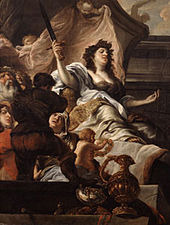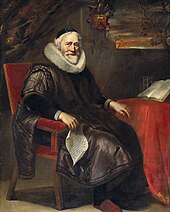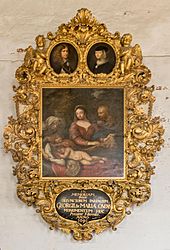Jürgen Ovens

Jürgen Ovens (* 1623 in Tönning ; † December 9, 1678 in Friedrichstadt ) was a painter from the Rembrandt circle. Most of his works were commissioned by the dukes of Schleswig-Holstein-Gottorf , and he was also successful as a portraitist in Amsterdam .
Life
Ovens was born the son of the wealthy councilor and merchant Ove Broders and his wife Agneta. The exact date of birth is unknown. His brother Broder Ovens also worked as a painter and art dealer. Ovens' son Friedrich Adolf Ovens († 1699) was also a councilor and painter in Tönning.
After basic training, possibly with the Tönningen painter Lorens de Keister, Ovens went to Amsterdam around 1640, where he did an apprenticeship in Rembrandt's workshop. He later worked in the workshop of Hendrick van Uylenburgh and his son Gerrit van Uylenburgh . In these circles Ovens got to know Govert Flinck , with whom he was artistically and personally closely connected. In 1651 Ovens returned permanently to Schleswig-Holstein and settled in Friedrichstadt , which was closely connected to the Netherlands. In 1652 Ovens married Maria Martens van Mehring († 1690), with whom he had ten children. In the same year he received from Duke Friedrich III. a privilege that, among other things, exempted him from city taxes. Ovens was never a court painter , however , this office was held by Johannes Müller. Ovens called himself a "freelance painter"; he did not belong to the court. Ovens' first time in Friedrichstadt fell during the most important years of the Gottorf heyday under Friedrich III, when the sciences and arts were promoted at court. For Friedrich III. and Duchess Maria Elisabeth painted Oven portraits and large-format history paintings. The painter also worked for other court members, such as Johann Adolph Kielmann von Kielmannseck .
This phase ended with the Second Northern War and Ovens and his family moved to Amsterdam in 1657. Through the mediation of the Uylenburghs and his reputation as “court painter” he was able to quickly win prestigious commissions. Over the course of time Ovens portrayed numerous representatives of the Amsterdam bourgeois nobility, including the anatomist Nicolaes Tulp , known from Rembrandt's anatomy by Dr. Tulip . For the Stadhuis in Amsterdam , Ovens reworked Govert Flinck's watercolor of the Batavian conspiracy under Iulius Civilis in 1662 , which hangs in the square to this day, instead of Rembrandt's painting, which never returned to the Burgerzaal of the Paleis op de Dam .
In 1663 Ovens returned permanently to Friedrichstadt and became court painter to the young Duke Christian Albrecht of Schleswig-Holstein-Gottorf , who renewed his privilege. The works for Christian Albrecht and his wife Friederike Amalie are the most extensive in their oeuvre. The court scholar Adam Olearius was involved in the conception of several pictures .
Ovens always kept in contact with the other country and probably traveled more often for shorter periods from Friedrichstadt to Amsterdam or vice versa. The last time he went to Amsterdam was in 1674. In 1675 Gerrit van Uylenburgh left the Netherlands, with which Ovens lost his most important mediator.
After about a year of illness, Ovens died on December 9, 1678 and was buried on January 21, 1679 in the Christophorus Church in Friedrichstadt. After the death of his wife, the heirs erected an epitaph in memory of both in the Laurentiuskirche in Ovens' hometown Tönning, for which paintings of the deceased were used.
plant
Ovens' work is characterized by the constant change between Schleswig-Holstein and the Netherlands, he is an important mediator of Dutch painting in the north. While his early works still clearly show the training in the Rembrandt workshop, Ovens increasingly turned to the international bright style, characterized by Flemish masters. Anthonis van Dyck is to be mentioned as the most important role model, which Ovens often took up and described in his notes with admiration. This development, which meant an orientation towards fashion and the market, is typical of Ovens' generation of painters and can also be observed in other Rembrandt students, e. B. Govert Flinck, Jacob Adriansz. Backer or Ferdinand Bol .
While some Ovens works in and around Amsterdam are still in their place of destination or in old possession, the extensive works from Gottorf Castle reached Copenhagen and Stockholm after 1713, when Gottorf fell back to the Danish King. Nevertheless, the Schleswig-Holstein state museums at Schloss Gottorf today again have a meaningful cross-section of Ovens' work.
The National Museum Stockholm owns large Ovens collections , especially the State Portrait Collection at Gripsholm Castle , and the Danish National History Museum at Frederiksborg Castle in Hillerød . This is where the majority of the Gottorf works ended up. The Gottorf cycle with scenes from the Gottorf story hangs today for the most part as a permanent loan from Frederiksborg in Christiansborg ; it is Ovens' largest surviving group of works. The elaborate painting of the Amalienburg, a pleasure house in Gottorfer Neuwerkgarten , is lost and can only be reconstructed on the basis of sketches.

Important and extensive graphic holdings belong to the collections of the Hamburger Kunsthalle and the Kunsthalle Bremen .
In Amsterdam there are Ovens works. B. in the Paleis op de Dam or the former community orphanage . The Rijksmuseum also has several paintings.
In northern Germany, mainly religious works have been preserved at their destinations, for example several pieces in the Schleswig Cathedral , in the Christophorus Church in Friedrichstadt or in the Ovens epitaph in the Laurentius Church in Tönning. The heavily damaged crucifixion from the Dargun Castle Church has been identified as Ovens again since 2013 .
Ovens' creative oeuvre includes paintings, drawings and etchings of various motifs. Ovens' complete work includes religious motifs, allegories, mythological motifs, portraits and still lifes.
literature
- August Sach: Ovens, Jürgen . In: Allgemeine Deutsche Biographie (ADB). Volume 25, Duncker & Humblot, Leipzig 1887, pp. 1-4.
- C. Eichhorn: Ovens, Jürgen (Juriaen) . In: John Rosén, Theodor Westrin (ed.): Nordisk familjebok konversationslexikon och realencyklopedi . 1st edition. tape 12 : Nådemedlen pontificate . Gernandts boktryckeri, Stockholm 1888, Sp. 494-495 (Swedish, runeberg.org ).
- FJ Meier: Ovens, Jurian (Jürgen) . In: Carl Frederik Bricka (Ed.): Dansk biografisk Lexikon. Tillige omfattende Norge for Tidsrummet 1537-1814. 1st edition. tape 12 : Münch – Peirup . Gyldendalske Boghandels Forlag, Copenhagen 1898, p. 482-484 (Danish, runeberg.org ).
- Harry Schmidt : The inventory of the estate of the painter Jürgen Ovens (= source collection of the Society for Schleswig-Holstein History 7). Vollbehr & Riepen, Kiel 1913.
- Harry Schmidt: Jürgen Ovens. His life and his works. A contribution to the history of Dutch painting in the XVII. Century. Self-published, Kiel 1922 ( archive.org ).
- P. Johansen: Ofens, Jürgen . In: Christian Blangstrup (Ed.): Salmonsens Konversationsleksikon . 2nd Edition. tape 18 : Nordlandsbaad – Perleøerne . JH Schultz Forlag, Copenhagen 1924, p. 689 (Danish, runeberg.org ).
- Harry Schmidt: Ovens, Jürgen . In: Hans Vollmer (Hrsg.): General lexicon of fine artists from antiquity to the present . Founded by Ulrich Thieme and Felix Becker . tape 26 : Olivier – Pieris . EA Seemann, Leipzig 1932, p. 103 .
- Schleswig-Holstein biographical lexicon . Volume 4, 1976, p. 177; Volume 5, 1979, p. 297.
- Lars Olof Larsson : Jürgen Ovens and painting at the northern European courts around the middle of the 17th century. In: Sven Olof Lindquist (Ed.): Economy and Culture in the Baltic. 1650-1700, Visby 1989, pp. 161-176.
- Ulrich Schulte-Wülwer (arrangement): Painting in Schleswig-Holstein. Catalog of the painting collection of the Städtisches Museum Flensburg. VA Boyens, Heide 1989, ISBN 3-8042-0467-8 , S. #.
- Eckardt Opitz : Jürgen Ovens. In: Who are our treasure and wealth. 60 portraits from Schleswig-Holstein. Christians, Hamburg 1990, ISBN 3-7672-1115-7 , pp. 55-57.
- Jan Drees: Ovens, Jürgen. In: New German Biography (NDB). Volume 19, Duncker & Humblot, Berlin 1999, ISBN 3-428-00200-8 , pp. 718-720 ( digitized version ).
- Harry Viehl: Jürgen Ovens (1623-1678). Drawings after paintings. Master's thesis at the University of Marburg 2000 ( harry-viehl.de ).
- Norbert Middelkoop: Jürgen Ovens in Amsterdam. A Reconnaissance of the Artist's Dutch Years. In: Nils Büttner, Esther Meier (Ed.): Border crossing. German-Dutch art and artist exchange in the 17th century. Marburg 2011, ISBN 978-3-89445-450-0 , pp. 123-138.
- Constanze Köster: Jürgen Ovens (1623–1678) and the staging of peace in painting in the middle of the 17th century. In: Nordelbingen. Volume 84, 2015, pp. 7-31.
- Constanze Köster: Jürgen Ovens (1623–1678). Painter in Schleswig-Holstein and Amsterdam (= studies on international architecture and art history. 147). Michael Imhof Verlag, Petersberg 2017, ISBN 978-3-7319-0369-7 .
- Tom van der Molen: Ovens, Jürgen . In: General Artist Lexicon . The visual artists of all times and peoples (AKL). Volume 94, de Gruyter, Berlin 2017, ISBN 978-3-11-023260-8 , p. 52.
Web links
- Literature by and about Jürgen Ovens in the catalog of the German National Library
- Works by Jürgen Ovens in museums in Schleswig-Holstein
- Works by Jürgen Ovens in the Rijksmuseum Amsterdam
Individual evidence
- ^ The information given by Joachim von Sandrart in 1620: 296. Juriaen Ovens . In: Teutsche Academie der Bau-Bildhauer- und Maler-Kunst,… The third main part of the second volume. Nuremberg, 1774, p. 365 ( books.google.de ). is wrong.
- ↑ Harry Schmidt: Jürgen Ovens. His life and works.… 1922, p. 10.
- ^ Constanze Köster: Jürgen Ovens (1623–1678). Painter in Schleswig-Holstein and Amsterdam. 2017, p. 21.
- ^ Harry Schmidt: Ovens, Friedrich Adolf . In: Hans Vollmer (Hrsg.): General lexicon of fine artists from antiquity to the present . Founded by Ulrich Thieme and Felix Becker . tape 26 : Olivier – Pieris . EA Seemann, Leipzig 1932, p. 103 .
- ^ Constanze Köster: Jürgen Ovens (1623–1678). Painter in Schleswig-Holstein and Amsterdam. 2017, p. 21 ff.
- ^ Constanze Köster: Jürgen Ovens (1623–1678). Painter in Schleswig-Holstein and Amsterdam. 2017, p. 25 ff.
- ↑ Harry Schmidt: Jürgen Ovens. His life and works.… 1922, p. 21, note 21.
- ^ Constanze Köster: Jürgen Ovens (1623–1678). Painter in Schleswig-Holstein and Amsterdam. 2017, p. 56 f.
- ^ Constanze Köster: Jürgen Ovens (1623–1678). Painter in Schleswig-Holstein and Amsterdam. 2017, p. 110 ff.
- ^ Constanze Köster: Jürgen Ovens (1623–1678). Painter in Schleswig-Holstein and Amsterdam. 2017, p. 161ff. Apparently the revision of his painting requested by Rembrandt did not take place; Constanze Köster: Jürgen Ovens (1623–1678). Painter in Schleswig-Holstein and Amsterdam. 2017, p. 164.
- ↑ Harry Schmidt: Jürgen Ovens. His life and works.… 1922, p. 121, p. 120 f.
- ^ Constanze Köster: Jürgen Ovens (1623–1678). Painter in Schleswig-Holstein and Amsterdam. 2017, p. 269 ff.
- ↑ Harry Schmidt: Jürgen Ovens. His life and works. ... 1922, p. 50.
- ^ Constanze Köster: Jürgen Ovens (1623–1678). Painter in Schleswig-Holstein and Amsterdam. 2017, p. 300 and passim.
- ^ Constanze Köster: Jürgen Ovens (1623–1678). Painter in Schleswig-Holstein and Amsterdam. 2017, p. 211 ff.
- ↑ Is Rembrandt-Schüler the creator of the painting? Retrieved February 11, 2017 .
- ^ Constanze Köster: Jürgen Ovens (1623–1678). Painter in Schleswig-Holstein and Amsterdam. 2017, p. 355 ff. (Catalog).
| personal data | |
|---|---|
| SURNAME | Ovens, Jürgen |
| ALTERNATIVE NAMES | Ofens, Jurian; Owens, Jurian; Ovens, Juriaen |
| BRIEF DESCRIPTION | German painter |
| DATE OF BIRTH | 1623 |
| PLACE OF BIRTH | Toenning |
| DATE OF DEATH | December 9, 1678 |
| Place of death | Friedrichstadt |


